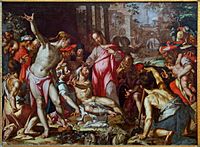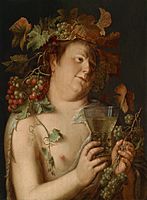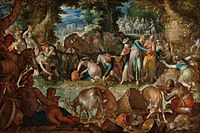Joachim Wtewael facts for kids
Quick facts for kids
Joachim Wtewael
|
|
|---|---|

Self-portrait, 1601
|
|
| Born |
1566 |
| Died | 1 August 1638 (aged 71–72) |
| Nationality | Dutch |
| Known for | Oil painting |
|
Notable work
|
Perseus and Andromeda, Louvre, small paintings on copper |
| Movement | Northern Mannerism |
Joachim Anthoniszoon Wtewael (Dutch pronunciation: [ˈyːtəʋaːl]; also known as Uytewael [ˈœytəʋaːl]) (1566 – 1 August 1638) was a Dutch Mannerist painter and draughtsman, as well as a highly successful flax merchant, and town councillor of Utrecht. Wtewael was one of the leading Dutch exponents of Northern Mannerism, and his distinctive and attractive style remained largely untouched by the naturalistic developments happening around him, "characterized by masterfully drawn, highly polished figures often set in capricious poses". Wtewael was trained in the style of late 16th-century Haarlem Mannerism and remained essentially faithful to it, despite painting well into the early period of Dutch Golden Age painting.
Altogether he has left about a hundred paintings, as well as drawings and some stained glass he designed. He painted a mixture of large paintings on canvas, and tiny cabinet paintings on copper plates, the latter the more numerous and typically the most distinctive. There is also a group of mid-sized paintings, often on panel. ..... Especially in his works on copper he returns to the same subjects in several works, but varying the compositions. The Adoration of the Shepherds, Venus and Mars Surprised by Vulcan, and the Feast of the Gods as the wedding feasts of Cupid and Psyche, Peleus and Thetis, the latter often combined with the Judgement of Paris, and Lot and His Daughters, are some examples of these favourite subjects. The first of these was painted in all sizes. ..... In some works he also revived the kitchen scene subjects of Pieter Aertsen from a half century before. According to Seymour Slive, "When well preserved his little pictures glow like gems".
He was very prosperous as a merchant of flax (for the manufacture of linen and canvas), which no doubt occupied much of his time, but was also famous as a painter in his own day, with his reputation reaching as far as Prague, where Emperor Rudolf II obtained his The Golden Age (now Metropolitan Museum of Art, New York). His large house on one of the main canals of Utrecht remains, though remodelled, and as well as family portraits the Utrecht museum has two very fine pieces of his furniture. He had several children, and seems to have stopped painting for almost the last decade of his life, perhaps influenced by the illness and death of his wife. Like his brother he was a city councillor; as a member of the main Dutch Reformed Church he was involved in the struggles with the Remonstrants. His best known work, and almost his largest, is the near life-size Perseus and Andromeda in the Louvre. Producing his highly finished small paintings was probably not very economic, and he was not short of money; his own pleasure and fame were probably his main motivations. His granddaughter still owned 30 of his paintings in 1669.
Reflecting an increase of interest in Wtewael's art in recent decades, in 2015–16 Pleasure and Piety: The Art of Joachim Wtewael (1566–1638), the first major exhibition devoted solely to his work, showed in Utrecht, Washington DC and Houston, Texas.
Contents
Life
Wtewael was born and spent almost all of his life in Utrecht, where he died. He was the son of a glassmaker and glass painter who had settled in Utrecht in 1566. He began his career in Utrecht, according to Carel van Mander, as a glassmaker and glass engraver in his father's workshop. In 1586, he began four years of travelling and living in Italy and then France, the latter in the household of the bishop of St Malo, Charles de Bourgneuf de Cucé. His main Italian base was in Padua, close to Venice, and his earliest works show awareness of the Second School of Fontainebleau, which was probably the result of visiting there.
Returning to Utrecht in about 1590 (by 1592 at the latest), Wtewael established a workshop and joined the saddlemakers' guild (which in Utrecht then covered painters as well) as a painter and began producing paintings, drawings, engravings, and stained glass. Later he was a founder member of the new Utrecht Guild of Saint Luke for the painters of Utrecht. He never lived elsewhere, and seems never to have travelled outside the Netherlands again. A gentlemanly contemporary in Utrecht, who might be thought in a good position to know the artist and his work, also praised very highly Wtewael's skill in sculpture, but no clear examples of this are known.
He married Christina Wtewael van Halen (1568–1629), whose portrait of 1601 makes a pair with the self-portrait illustrated. In 1596 they had a son Peter Wtewael, who became a painter; their other son, Jan (1598–1652), may also have been a painter as, unlike Peter, he registered with the guild, in 1639 after his father's death. Joachim von Sandrart, visiting Utrecht in 1626, complained that Peter and his father neglected painting for the flax business. In the portraits by Joachim of his two sons, Peter is shown as a painter and Jan as a "humanist", carrying a book. Peter died a wealthy man in 1660, having remodelled the family house in 1639, the year after his father died.
In the late 1620s Joachim painted portraits of both his sons, dated 1628, his daughter Eva (1607–1635, see gallery) and a pair of his other daughter and her husband Johan Pater, dated 1626. All of these are in Utrecht. Burial records suggest several other children died young, but their birthdates are unknown. Wtewael's dated paintings stretch from 1592 to 1628, taking him from the age of 26 to 62.
He was on the town council in 1610 and was later awarded a seat for life by the Stadtholder Maurice, Prince of Orange for his loyalty against the Remonstrants. However his brother was also rewarded in this way and Utrecht had a rule against more than one brother being on the council at any time. So he did not take up his seat until 1632, after his brother had died. Despite a reasonable amount of documentary records, the leading scholar of his work has written that "Wtewael the man is essentially inscrutable".
Collections
The largest collection of his work, which includes a self-portrait (1601), and several other family portraits, is in the Centraal Museum, Utrecht, who were given works that had remained in the family until recent decades. Several other Dutch, German, British and American museums have works, but many also remain in private collections.
Some large zoomable images:
- Mars and Venus Surprised by Vulcan, about 1606 – 1610, 20.3 x 15.5 cm (8 × 6 1/8 in.). Getty Museum, Malibu
- The Holy Family with Saints and Angels, c. 1606–1610, oil on copper, 19.8 x 15.5 cm, Museo Thyssen-Bornemisza, Madrid
- The Judgement of Paris, 1615, National Gallery, London
Gallery
Large paintings
-
A Kitchenmaid, in the background Jesus in the house of Mary and Martha, 1620–25. Close to works by Pieter Aertsen, 103 x 72 cm
-
His daughter Eva Wtewael (1607-1635), 1628, shown needleworking, not typical for a portrait of a wealthy woman
-
Bacchus, about 1628, one of his last works
Smaller paintings
See also
 In Spanish: Joachim Wtewael para niños
In Spanish: Joachim Wtewael para niños
- City of Gotha and Federal Republic of Germany v. Sotheby's and Cobert Finance S.A.











